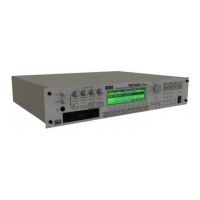49
Basic functions
Program mode
keyboard. With a negative (–) value, the volume
will decrease as you play lower on the keyboard.
• When Ramp “High” has a positive (+) value, the
volume will increase as you play higher on the
keyboard. With a negative (–) value, the volume
will decrease as you play higher on the keyboard.
Amp Mod.
“Velocity Int” is used by most programs to decrease
the volume of softly played notes and increase the vol-
ume of strongly played notes, and this Amp Modula-
tion parameter adjusts the depth of this control.
Normally you will set Amp Modulation to positive (+)
values. As this setting is increased, there will be greater
volume difference between softly played and strongly
played notes.
LFO1 Mod., LFO2 Mod.
Specify how the LFO’s will produce cyclic changes in
volume (the tremolo effect).
The volume will be affected by the LFO(s) for which
you set an “Intensity (LFO1 Intensity, LFO2 Intensity)”
value.
“Int (AMS Intensity)” adjusts the depth by which the
tremolo effect produced by the LFO will be affected
when you operate an “AMS (LFO1 AMS, LFO2 AMS).”
For example if you set “AMS” to JS-Y #02, tremolo will
be applied when you move the joystick of a MIDI-con-
nected TRITON etc. toward yourself, or when CC#02 is
received.
EG page
Here you can make settings for the amp EG, which
changes the volume over time.
Every instrument has its own characteristic curve of
volume change. This is part of what gives each instru-
ment its identifiable character. Conversely, by applying
a strings-type Amp EG curve to an organ-type multi-
sample, you can produce a sound with a character
unlike a typical organ.
Piano
Organ
Strings
LFO settings 5.3: Ed–LFOs
For each oscillator, you can use two LFO (Low Fre-
quency Oscillator) units: LFO1 and LFO2. You are free
to select the type of each LFO and set its speed.
The depth of the LFO1 and LFO2 that you specify here
is adjusted by the settings of the 3.1: Ed-Pitch, 4.1: Ed-
Filter1, 4.2: Ed-Filter2, 5.1: Ed-Amp1, and 5.2: Ed-
Amp2 pages.
OSC1 LFO1, OSC1 LFO2, OSC2 LFO1, OSC2 LFO2
“Waveform” selects the type of LFO. You can choose
from a variety of waveforms, including standard wave-
forms such as Triangle, Saw, Square, and Sine, as well
as Step or Random PG waveforms that produce a sam-
ple-and-hold effect (
☞PG p.23).
You can create a wide variety of effects by adjusting the
“Ofs,” “Fade,” and “Dly” settings, and by changing
the sign (+/-) of the “Intensity” setting in the 3.1: Ed-
Pitch, 4.1: Ed-Filter1, 4.2: Ed-Filter2, 5.1: Ed-Amp1, and
5.2: Ed-Amp2 pages. “Frequency” specifies the speed
of the LFO.
Freq.Mod (Frequency Modulation)
“AMS” can be used to vary the LFO speed. This lets
you change the LFO speed by operating a controller, or
by the EG or Keyboard Track settings.
MIDI/Tempo Sync.
If “MIDI/Tempo Sync” is checked, the “Frequency”
setting will be ignored, and the LFO will synchronize
to the tempo of the arpeggiator etc. This lets you pro-
duce vibrato, wah, auto-pan, or tremolo that is syn-
chronized to the playback speed of the arpeggiator.
Arpeggiator settings 6.1: Ed–Arp.
Here you can make arpeggiator settings (☞p.85).
BUS settings 7.1: Ed–BUS
You can specify the oscillator routing (the signal sent to
the insert effects, master effects, and independent out-
puts) (☞p.95).
Insert Effect settings 7.2: Ed–InsertFX
Here you can select insert effects and make settings for
them (☞p.95).
Master Effect settings
7.3: Ed–MasterFX
Here you can select master effects and make settings
for them. The master EQ is also set here (☞p.96).

